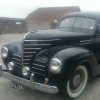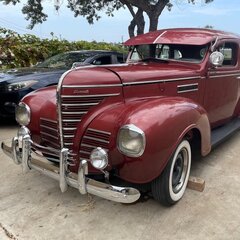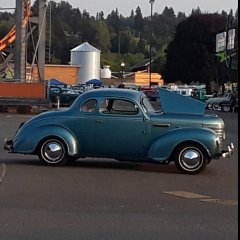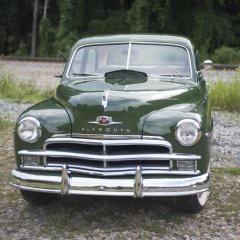-
Posts
111 -
Joined
-
Last visited
Reputation
5 NeutralProfile Information
-
Gender
Male
-
Location
Suffolk, UK
-
My Project Cars
1939 Plymouth Touring Sedan Export Model RHD; 1968 Ford Mustang Hardtop Challenger 289 V8 Cruise-O-Matic; 1964 1/2 Ford Mustang 260 V8 Cruise-O-Matic; 1954 Riley RME 1 1/2 Litre saloon
Contact Methods
-
Biography
Classic car enthusiast/restorer
-
Occupation
journalist
Converted
-
Location
England, UK
-
Interests
Car restoration, film photography, golf, cycling, camping
Recent Profile Visitors
1,057 profile views
-
Many thanks - this does make sense as the keys were bought as Plymouth/Chrysler items in a small job lot from a dealer in the US
-
Very interesting ! I reckon he would benefit from several of those mods.......
-
Yes that's true DJ but interestingly my other Yale key blanks stamped Plymouth on the rear side don't have any numbers either......
-
Thanks Dan. They came with a batch of Chrysler keys so I thought they might be for an automobile....
-
Not visited the forum for a while - as a change in personal circumstances led me to sell my lovely old 1939 RHD Plymouth Touring Sedan. Happily it has gone to a good home - an avid collector living in Hong Kong where they drive "on the wrong side of the road" as we do here in the UK. I wanted to say what an absolute pleasure it has been to be a member of this forum over the past four years. The generosity, kindness and cameraderie in sharing priceless technical knowledge and experience has often left me speechless. I'll miss this friendship greatly - and I thank you all for it with the utmost sincerity. I have one final request for help please. Sorting through my small box of leftover Plymouth bits I found some 1938-48 trunk/ignition key blanks that I'm eBaying over here. But there are also two brass Yale key blanks that I can't identify. If anyone can tell from the images I've posted I'd be most grateful - as someone may be glad of them. Thanks fellas.
-
Thanks Plymouthy - I think that's what I did but it went base over apex......could be my connection dropped out momentarily. We've severe winter weather here and it's affecting everything from travel to phone lines and internet.....
-
Seat position might certainly be an issue IMHO. I have a 39 Plymouth Sedan with three on the floor. Even with the shifter exiting the trans relatively near the clutch housing, when selecting first the shifter is virtually in the passenger's lap. Remember mine is a RHD car so the shift positions are "the wrong way round" compared with your LHD models. I sure need to be good friends with my passenger! BTW when I try to paste an emotion on here, it wipes all the text I've just written. Am I being a klutz or is it a bug in the system?
-

Chrysler L Head Heat Riser - Repair or Scrap?
likaleica replied to likaleica's topic in P15-D24 Forum
I agree the term "open" is open (sorry!) to interpretation. I was following this description for the flap position when the gases go mainly through the exhaust system because that is the term used in the forum technical article on the heat riser. -

Chrysler L Head Heat Riser - Repair or Scrap?
likaleica replied to likaleica's topic in P15-D24 Forum
Thanks plyroadking and 1949 Goat for those very useful remarks. Living in England we can encounter cold weather tho usually not extreme - and thanks to climate change now mostly avoid very harsh winters. Added to that I usually store the Plymouth over winter, just giving her the occasional start up and run along the lane on my land to keep everything free. So far I'm erring toward welding the riser plate in the open position............ -
Happy New Year from England to all - and happy Moparing in 2017! I've seen conflicting views on here about the merits of the heat riser between the exhaust and inlet manifolds on the L head straight six - as on my 39 Plymouth Touring Sedan. As we know, this is the device that when closed, allows some of the exhaust gases up into the inlet manifold and when open (see photo), directs virtually all the exhaust gases out through the exhaust system. On the one hand, the excellent forum technical article on the heat riser says: End of argument then...............but I've seen other members proposing to scrap the heat riser! So who is right? My own experience of interlinked inlet/exhaust manifolds is from the famous Riley twin cam hemi head 1.5 litre. This is a crossflow engine with tubes running through the cylinder head and engine block to link the manifolds. Enthusiasts commonly blanked these tubes off and reckoned the engine ran better as a result. I've been forced to replace the exhaust manifold on my 39 Plymouth and cant decide whether to repair the heat riser, weld it in the open position - or remove it and blank off the exhaust from the inlet manifold with thick steel plate. I'd be very interested in any views on this!
-

1940 Plymouth missing water distribution tube
likaleica replied to John Goldsmith's topic in P15-D24 Forum
Some very nice cars pictured here guys - never knew so many are in OZ! And Happy New Year from England to everyone on here. Worries about breaking studs when removing exhaust manifolds are well founded. This happened on my 39 Plymouth Sedan, in spite of them being soaked for weeks previously in Freeway releasing fluid (similar to Plus Gas.) I wondered afterwards if some gentle heat from a blowtorch might have helped avoid this. Having to drill them out is no fun at all - particularly the one nearest the firewall! Interested in the comment about isolating the upriser flap between the exhaust manifold and the inlet manifold/carburettor. I've sourced a new exhaust manifold to replace my broken one and I really don't want to bother with the flap. For a start the bimetal spring is broken so it won't open and close correctly, and the spindle is worn so there would be exhaust/inlet leaks. My Carter B&B carb has a manual choke anyway, and the car is not used in very cold weather. Does anyone have any views on how I should proceed? Should I weld the flap "open" (allowing maximum flow out of the exhaust and minimal flow to the inlet manifold - see photo attached) or remove the flap completely, weld up the spindle holes and blank off the entire flange between the exhaust and inlet manifolds with a thick steel plate? If I did the latter, should I cut a small slot in the blank plate to allow a little heat flow up into the inlet (as happens when the flap is in the aforementioned "open" position) As for the WD tube issue, I bought one from Andy Bernbaum before I realised that my car has the shorter 23" engine (thanks to Andydodge for alerting me to this fact!!) Does anyone know how long the WD tube for the 23" block should be (or the 25" for that matter)? I don't want to strip the water pump out before confirming I have the right tube! I am fearing that the studs will break when I try to remove the water pump - is this as common as the exhaust studs breaking? I've read that the WD tube is often disintegrated in the block - how easy is it to remove the debris and is it usually an "engine out/strip down" scenario? Sorry to ask so many questions but there is little knowledge of these cars here in the UK and this forum has made my continued ownership of my Plymouth possible! Thanks to all who read this. -
Incredibly detailed and well filmed documentary............thanks very much for posting it. Does this plant still exist or has it long since closed like most of the great car factories here in the UK such as Jaguar, MG, Austin, Morris, Riley, Triumph to name just a few?
-
Thanks for the clarification Andyd! So I can now see that the issue is not RHD versus LHD but that certain manifolds/headers will not fit my engine - in particular from later models, because of the RHD configuration. Part of the problem is I've entrusted the work to a repair shop some miles away from me and have not had chance to get over to see the stripped headers/manifolds myself. Just last night the guy sent me photos and mine is clearly a "rear dump" type. I am going to try Dallas Auto here in the UK mentioned by UKPlymouth. Fingers crossed!
-
Thank you. Then you are not too far from me in Suffolk then! Strangely enough I bought the Plymouth from Stephen the owner of Dallas Auto in 2014. It will be a long shot that they'll have a RHD manifold for this engine but I'll ask them anyway. Will keep an eye out for that Sywell meet. Do you know where in South Africa the Chrysler assembly plant was as a matter of interest? I met an American car buff last year who reckoned my car probably came out of a vast collection of American vehicles hoarded by a man named Eddie Hall in Rhodesia (Zimbabwe) when he died some years ago - but I have no idea if this is true. Like so many imports there was not a scrap of history with the car.
-
Hi John - welcome to this fantastic forum with so many very expert and kind members. I could not have made my own fairly recent foray into ancient American cars without them. Please send me a private message so we can keep in touch.






